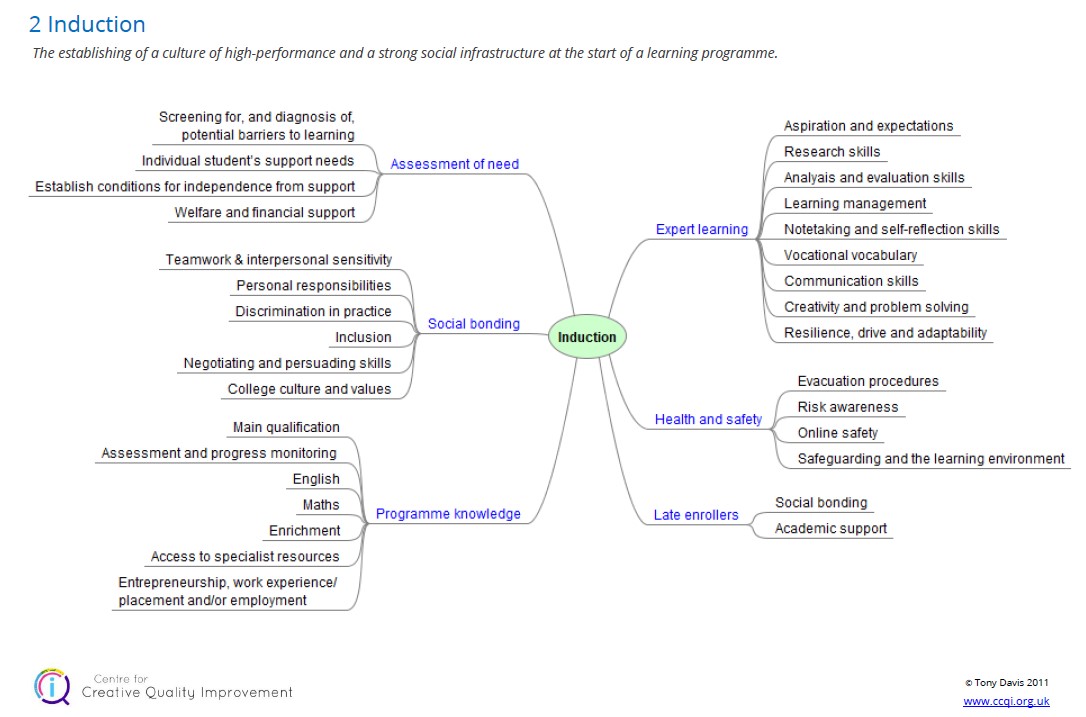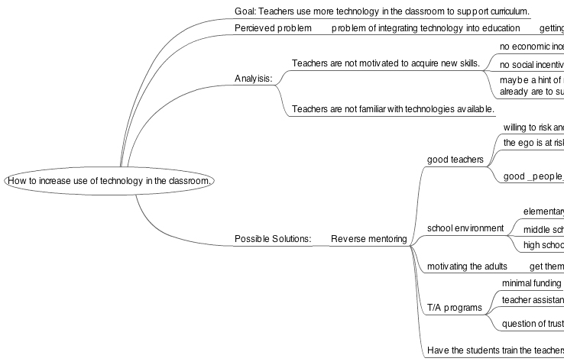Mind mapping
What is it?
Mind Mapping is a technique for exploring and developing ideas and concepts. It can be used in a wide range of situations from the serial planning of an activity to the creative process:
| planning: | meetings, events, projects, writing… |
| organising: | ideas, resources, criteria, priorities… |
| communicating: | the big picture, related details, discrete associations… |
| developing: | thoughts, concepts, solutions to problems… |
| creating: | ideas, prose, music… |
Mind Mapping can be carried out by hand or using a computer program.
What does it look like?
Around a central idea, subject or focus, the user graphically explores a set of key discrete elements, or branches of thought. Each element is then further subdivided into ever-smaller constituent parts. The power of an effective mind map is the ability to see an idea in its entirety and to understand the interrelationship of the detail.
Mind map: How to increase the use of technology in the classroom
Click to see this mind map in full.
Computer-generated mind map courtesy of http://freemind.sourceforge.net/wiki/index.php/Download
Where in the learner’s journey are you likely to come across it?
Teaching and learning
- as a learning aid
- to improve creativity
- to develop logical thought processes
- to explore and understand a central theme
- to understand the interrelationships around a central theme
- to develop team- and group-working skills
Support
- as a tool to help dyslexic learners organise their thoughts
How can teachers, trainers & learners use it?
The mind-mapping technique uses so called left-brain and right-brain thinking; it is understood that we each have a greater tendency to work from one particular side.
|
Left brain |
Right brain |
|
|
Using this graphical approach to brainstorming, teachers can help learners to draw on their particular innate ability while helping them to develop the complimentary skill set.
Each addition to the ‘map’ has the potential to trigger further thoughts, connections and associations so that it becomes both a reflective account of the journey of discovery and the stimulus for further thinking.
What impact can it have on learning?
When learners create associations they make sense of their world by contextualising information and ideas, so deepening understanding and improving recall. Part of this process is the gathering of key ‘thought branches’ within a boundary to create a ‘highlight cloud’. This act of ‘chunking’ elements together is an effective technique for strengthening associations and committing information to long-term memory.
When using ‘linear notation’ (our default process for learning through reading) learners can experience difficulties with the:
- start of their thought process or creative endeavour
- the development of their ideas, and
- the resolution of their thinking.
As mind mapping is an explosion of divergent thinking, it avoids the issues of linearity. It could be described as the difference between a road map showing two cities and all the possible routes between them, and a route map showing a specific journey from one to the other.
At its best it will… (where appropriate – help for judging good or better)
At its best, a learner with effective mind mapping skills will be in control of their thinking; whether this is for the extremes of creative endeavour or project management. They are likely to be, or become independent learners. In a group discussion, all learners will be involved, and enthusiastic. Most will be surprised and motivated by the connections they make and the creativity of the approach.
At its worst it will… ( where appropriate – help for judging satisfactory or worse)
At its worst, a learner will be taught a process without the opportunity for autonomous practise on a relevant project. In group work, the teacher may find it difficult to engage the learners. There may be a lack of energy and creativity, and little new learning to reflect on or consolidate.
What are the safeguarding implications?
As in any group work, there is potential for stronger personalities to dominate and for less confident learners to feel intimidated.
Find out more
- For general information: http://mindmapping.com/
- www.mind-mapping.co.uk
- http://www.thinkbuzan.com
- For a list of commercial and free-to-download software: http://en.wikipedia.org/wiki/List_of_mind_mapping_software
For which CIF (2009/12) evaluative statements could it generate evidence?
| B1 How effectively do teaching, training and assessment support learning and development? |
B1.2 interesting and appropriate teaching and learning methods and resources inspire and challenge all learners and enable them to extend their knowledge, skills and understanding
B1.3 technology is used effectively to promote and support learning, where appropriate






Comments
No comments yet